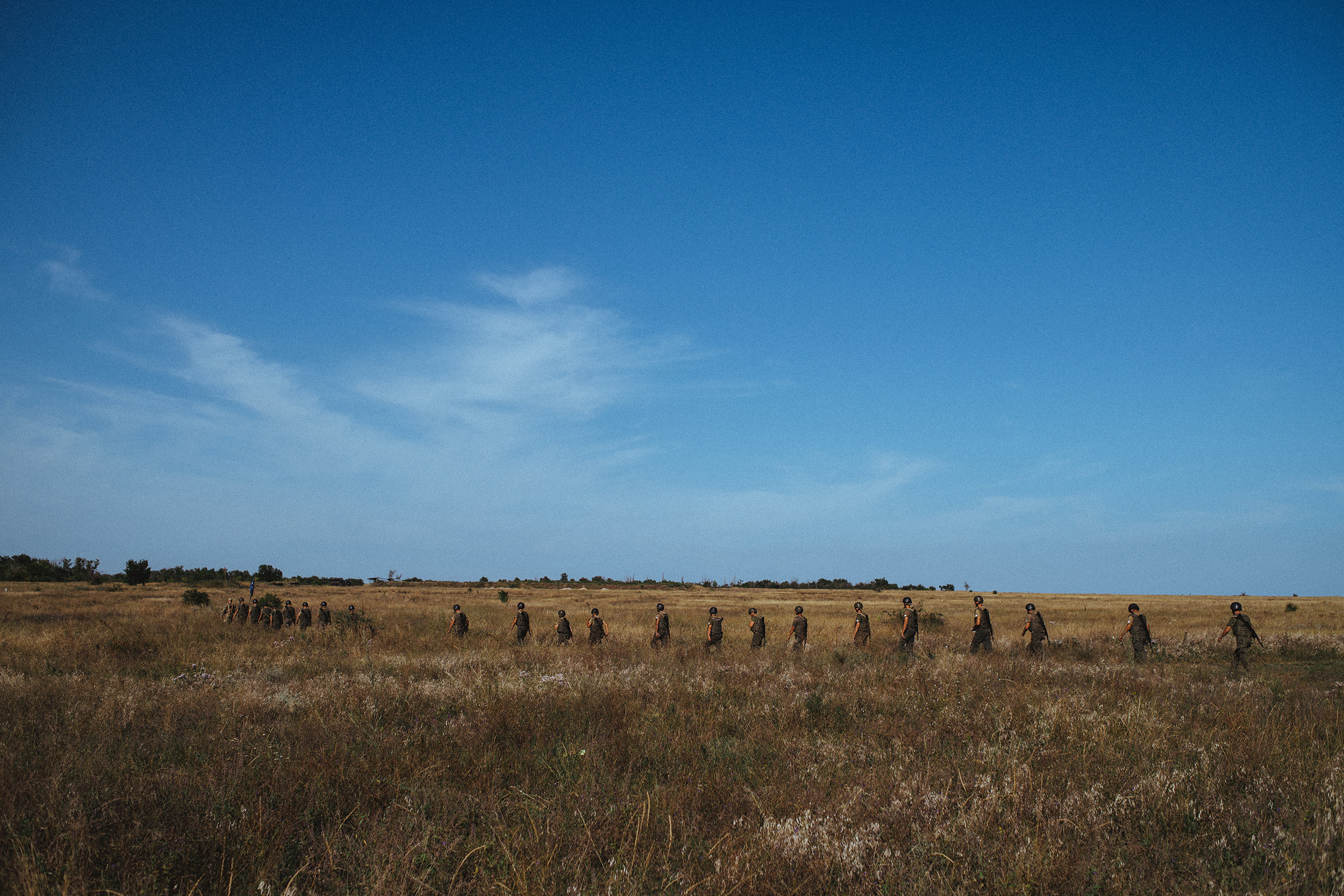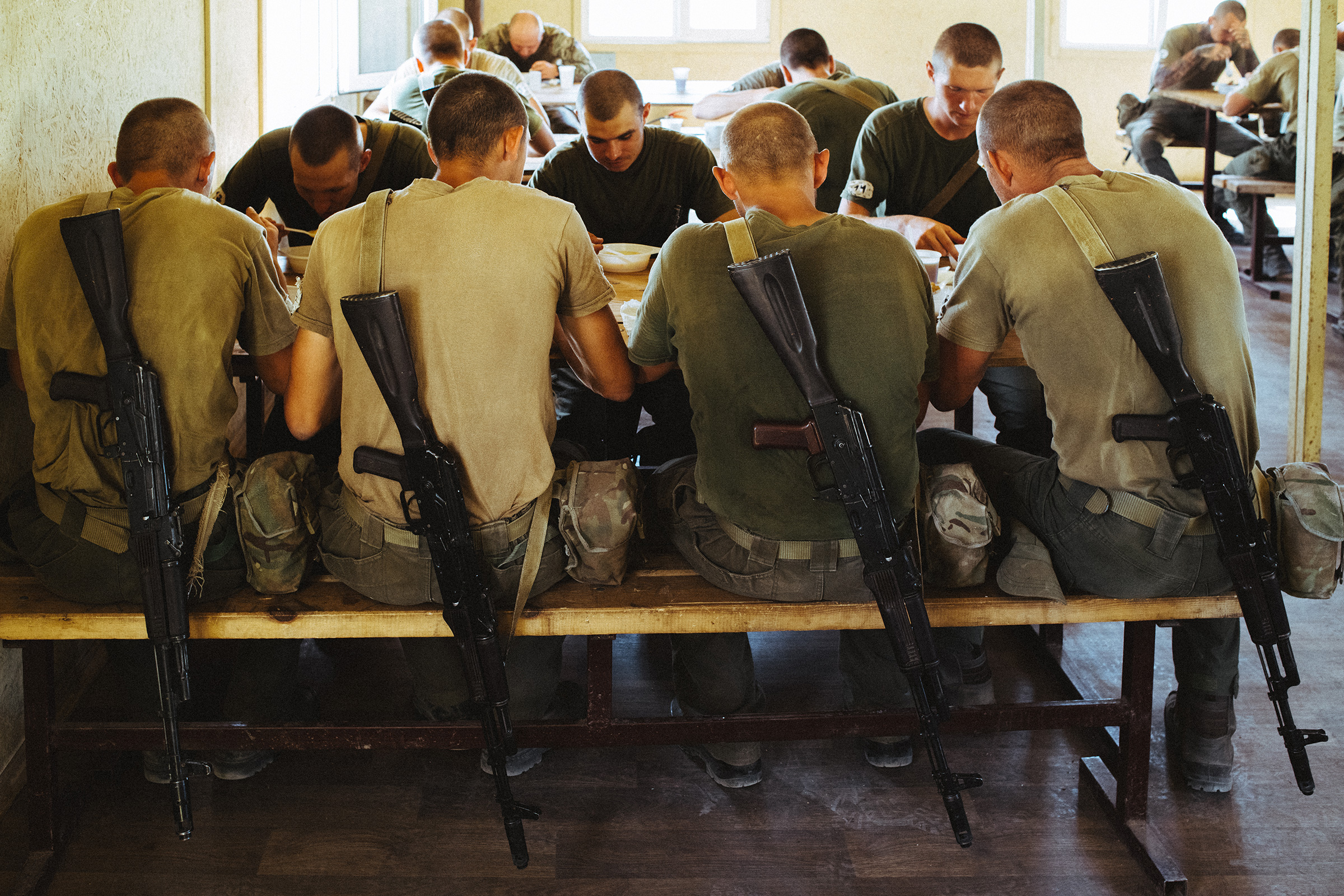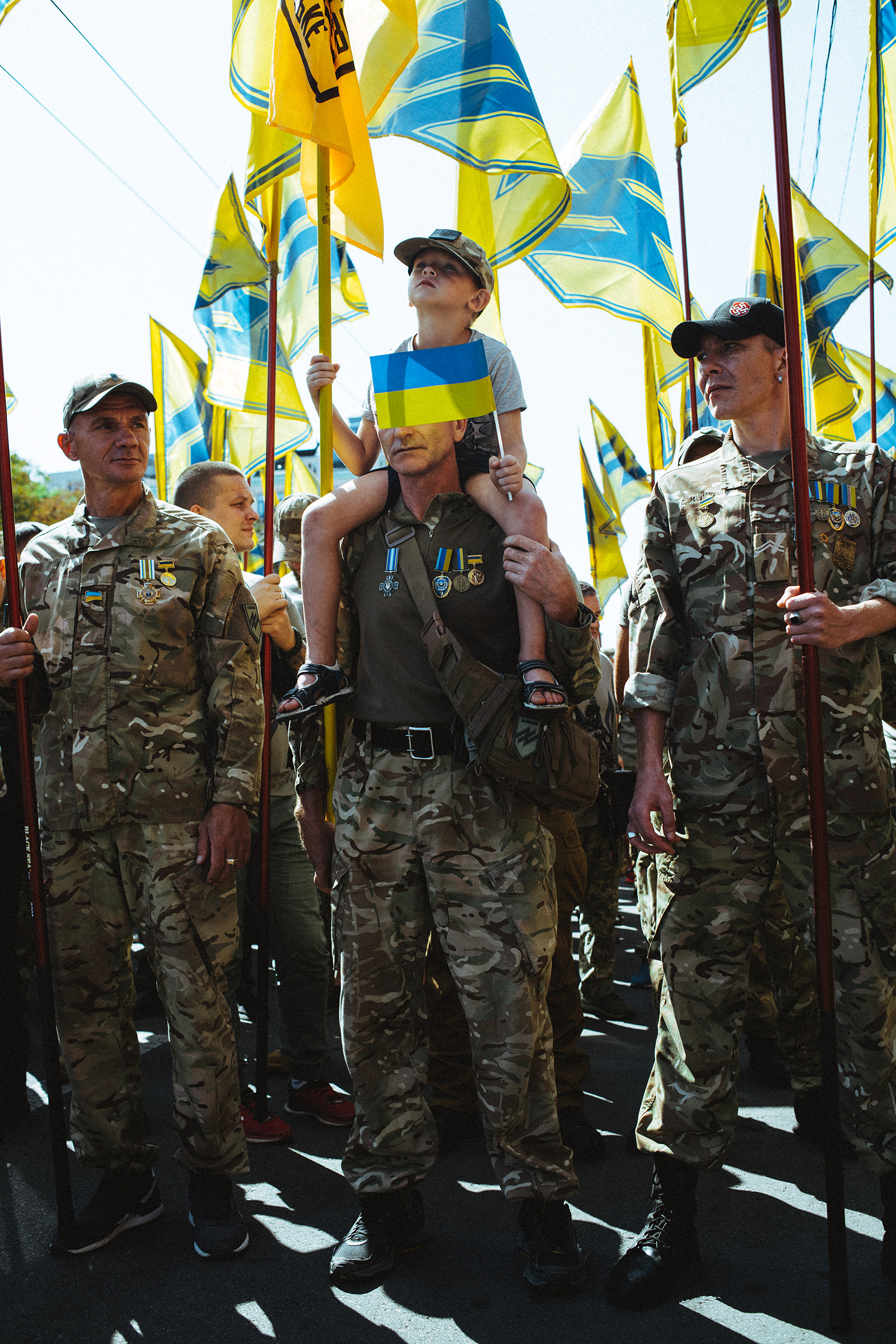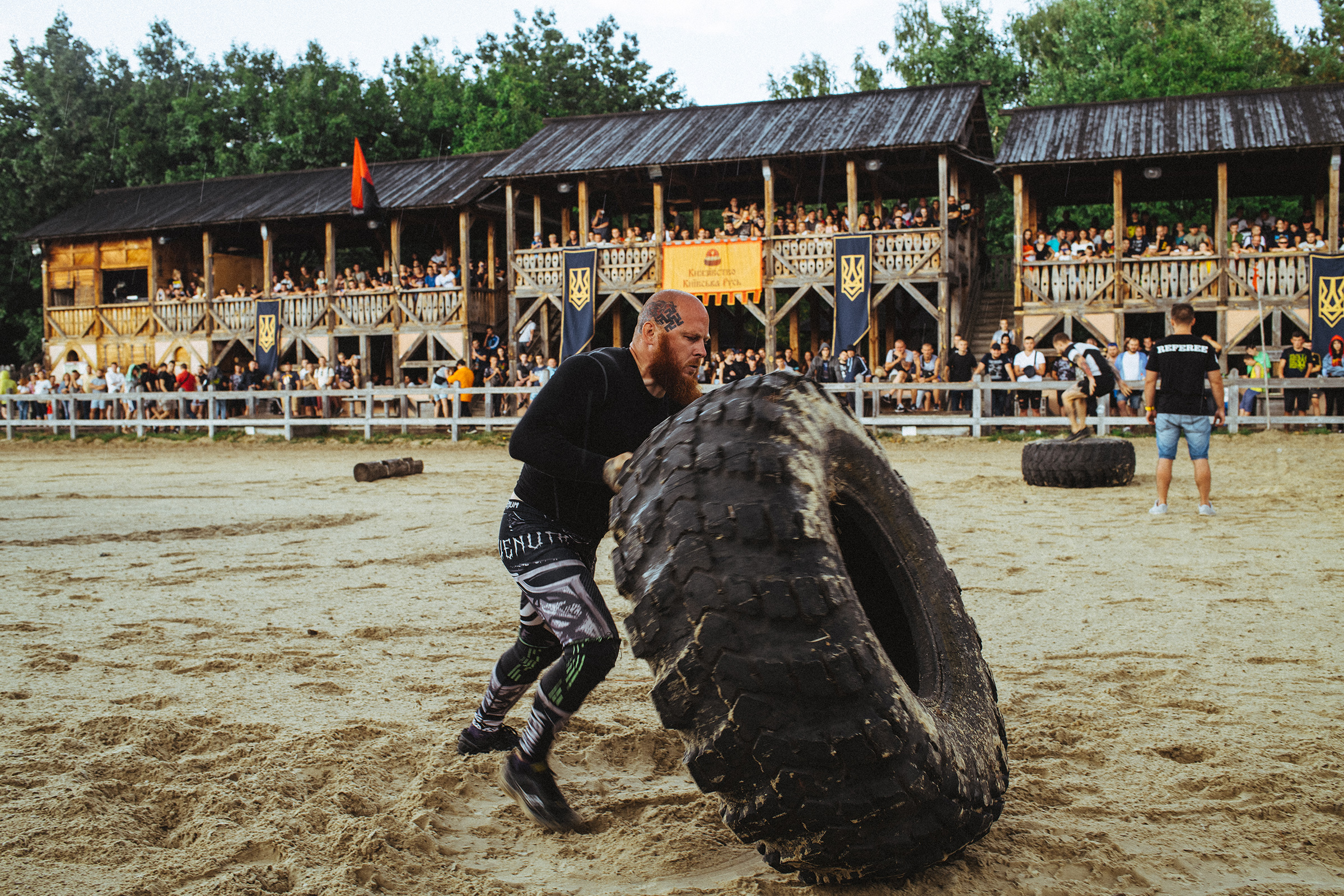The snow had just melted on the streets of Kyiv when Shawn Fuller, a U.S. Navy veteran, arrived in the early spring of 2018, his roller suitcase clattering over the pavestones of the Ukrainian capital. On the western edge of town, he found the address that his recruiter had sent him via Facebook, a flophouse with about two dozen beds, each reserved for a foreign fighter.
The men Fuller met inside were mostly from Europe, as was his recruiter, a chain-smoking Norwegian named Joachim Furholm, who had been convicted of bank robbery in Norway in 2010. The two of them had met over Facebook and gotten to know each other well, gaming out their plans to get military training and combat experience from one of Ukraine’s militia groups.
When they finally rendezvoused, Fuller noticed the swastika tattoo on the middle finger of Furholm’s left hand. It didn’t surprise him; the recruiter had made no secret of his neo-Nazi politics. Within the global network of far-right extremists, he served as a point of contact to the Azov movement, the Ukrainian militant group that has trained and inspired white supremacists from around the world, and which Fuller had come to join.
Its fighters resemble the other para-military units—and there are dozens of them—that have helped defend Ukraine against the Russian military over the past six years. But Azov is much more than a militia. It has its own political party; two publishing houses; summer camps for children; and a vigilante force known as the National Militia, which patrols the streets of Ukrainian cities alongside the police. Unlike its ideological peers in the U.S. and Europe, it also has a military wing with at least two training bases and a vast arsenal of weapons, from drones and armored vehicles to artillery pieces.
Outside Ukraine, Azov occupies a central role in a network of extremist groups stretching from California across Europe to New Zealand, according to law enforcement officials on three continents. And it acts as a magnet for young men eager for combat experience. Ali Soufan, a security consultant and former FBI agent who has studied Azov, estimates that more than 17,000 foreign fighters have come to Ukraine over the past six years from 50 countries.
The vast majority have no apparent links to far-right ideology. But as Soufan looked into the recruitment methods of Ukraine’s more radical militias, he found an alarming pattern. It reminded him of Afghanistan in the 1990s, after Soviet forces withdrew and the U.S. failed to fill the security vacuum. “Pretty soon the extremists took over. The Taliban was in charge. And we did not wake up until 9/11,” Soufan tells TIME. “This is the parallel now with Ukraine.”
At a hearing of the House Committee on Homeland Security in September 2019, Soufan urged lawmakers to take the threat more seriously. The following month, 40 members of Congress signed a letter calling—unsuccessfully—for the U.S. State Department to designate Azov a foreign terrorist organization. “Azov has been recruiting, radicalizing, and training American citizens for years,” the letter said. Christopher Wray, the director of the FBI, later confirmed in testimony to the U.S. Senate that American white supremacists are “actually traveling overseas to train.”
The hearings on Capitol Hill glossed over a crucial question: How did Azov, an obscure militia started in 2014 with only a few dozen members, become so influential in the global web of far-right extremism? TIME, in more than a dozen interviews with Azov’s leaders and recruits, found that the key to its international growth has been its pervasive use of social media, especially Facebook, which has struggled to keep the group off its platform. “Facebook is the main channel,” says Furholm, the recruiter.
In a statement to TIME, Facebook defended its recent attempts to deal with the proliferation of right-wing extremists, saying it has banned more than 250 white-supremacist groups, including Azov. “As they evolve their efforts to return to the platform, we update our enforcement methods with technology and human expertise to keep them off,” the statement said.



Yet its attempts to crack down have been far from fully effective. While Facebook first designated the Azov Battalion a “dangerous organization” in 2016, pages linked to the group continued to spread propaganda and advertise merchandise on the platform in 2020, according to research by the Center for Countering Digital Hate published in November. Even in December, the Azov movement’s political wing, the National Corps, and its youth wing maintained at least a dozen pages on Facebook. Some began disappearing after TIME posed questions about Azov to Facebook.
That online game of catch and delete, which Facebook says is central to its counter-extremism strategy, will hardly address the deeper problem posed by Azov and its allies. Apart from offering a place for foreign radicals to study the tricks and tools of war, the Azov movement, through its online propaganda, has fueled a global ideology of hate that now inspires more terrorist attacks in the U.S. than Islamic extremism does and is a growing threat throughout the Western world.
After the worst such attack in recent years—the massacre of 51 people in Christchurch, New Zealand, in 2019—an arm of the Azov movement helped distribute the terrorist’s raving manifesto, in print and online, seeking to glorify his crimes and inspire others to follow. In the 16 years that followed the attacks of 9/11, far-right groups were responsible for nearly three-quarters of the 85 deadly extremist incidents that took place on American soil, according to a report published in 2017 by the U.S. Government Accountability Office.
In their letter to the State Department in 2019, U.S. lawmakers noted that “the link between Azov and acts of terror in America is clear.” The Ukrainian authorities have also taken notice. In October, they deported two members of the Atomwaffen Division, a U.S.-based neo-Nazi group, who were trying to work with Azov to gain “combat experience,” according to a report in BuzzFeed News that cited two Ukrainian security officials.
Among Azov’s closest American allies has been the Rise Above Movement, or RAM, a far-right gang, some of whose members have been charged by the FBI with a series of violent attacks in California. The group’s leader, Robert Rundo, has said his idea for RAM came from Ukraine’s far-right scene. “This is always my whole inspiration for everything,” he told a right-wing podcast in September 2017, referring to Azov as “the future.” “They really have the culture out there,” he said. “They have their own clubs. They have their own bars. They have their own dress style.”

The main recruitment center for Azov, known as the Cossack House, stands in the center of Kyiv, a four-story brick building on loan from Ukraine’s Defense Ministry. In the courtyard is a cinema and a boxing club. The top floor hosts a lecture hall and a library, full of books by authors who supported German fascism, like Ezra Pound and Martin Heidegger, or whose works were co-opted by Nazi propaganda, like Friedrich Nietzsche and Ernst Jünger. On the ground floor is a shop called Militant Zone, which sells clothes and key chains with stylized swastikas and other neo-Nazi merchandise.
“It could be described as a small state within a state,” says Olena Semenyaka, the head of international outreach for the Azov movement. On a tour of the Cossack House in 2019, she told TIME that Azov’s mission was to form a coalition of far-right groups across the Western world, with the ultimate aim of taking power throughout Europe.
It might seem ironic for this hub of white nationalists to be situated in Ukraine. At one point in 2019, it was the only nation in the world, apart from Israel, to have a Jewish President and a Jewish Prime Minister. Far-right politicians failed to win a single seat in parliament in the most recent elections. But in the context of the white-supremacist movement globally, Azov has no rivals on two important fronts: its access to weapons and its recruiting power.
The movement arose as a product of the revolution that swept Ukraine in 2014. In one of their first official acts, the revolution leaders granted amnesty to 23 prisoners, including several prominent far-right agitators. They included Andriy Biletsky, who had spent the previous two years in jail on charges of attempted murder. He maintained that the case against him was politically motivated, part of an unfair crackdown on local nationalists.
Ukrainian police had long treated his organization, Patriot of Ukraine, as a neo-Nazi terrorist group. Biletsky’s nickname within the group was Bely Vozhd, or White Ruler, and his manifesto seemed to pluck its narrative straight from Nazi ideology. Ukrainian nationalists, it said, must “lead the white nations of the world in a final crusade for their survival, a crusade against the Semite-led Untermenschen,” a German term for “subhumans” with roots in Nazi propaganda.
Within days of his release, Biletsky set out to assemble a far-right militia. “That was our rise to the surface after a long period underground,” Biletsky told TIME in an interview that winter in Ukraine. The insignia he chose for the militia combined two symbols—the “black sun” and the “wolf’s hook”—both of which were used by the German Nazis during World War II.

In response to Ukraine’s pro-Europe revolution, which sought to bond the former Soviet republic more closely to the West, Russian forces seized control of two major cities and dozens of towns in eastern Ukraine. The new government in Kyiv, desperate in the face of this invasion, sought allies where it could find them, even among groups that embraced anti-democratic ideologies. Biletsky’s group proved a particularly effective example, beginning its rapid rise as the Azov Battalion. The name was derived from the Sea of Azov coast, where it first saw major combat.
Among the militias that formed to resist the Russian forces, Biletsky’s followers turned out to be among the most disciplined and battle-ready. “They held the line even after everybody left,” says Serhiy Taruta, a metals magnate and former governor of the frontline region of Donetsk who helped finance and equip Azov in the early months of the war. For their bravery on the battlefield, Biletsky and other Azov commanders were lauded as national heroes. “These are our best warriors,” then President Petro Poroshenko said at an award ceremony in 2014. “Our best volunteers.”
From across Europe and the U.S., dozens of fighters came to join Azov that year, many of them bearing tattoos and rap sheets earned in the neo-Nazi underground back home. The Ukrainian authorities welcomed many of them, and in some cases granted them citizenship. Within the war’s first year, Biletsky’s militia was officially absorbed into the National Guard, becoming a regiment within Ukraine’s armed forces.
That status came with an arsenal that no other far-right militia in the world could claim, including crates of explosives and battle gear for up to 1,000 troops. On prime-time talk shows in Ukraine, Biletsky and his lieutenants were treated as warrior-celebrities, and they used their fame as a springboard into politics. Biletsky won a seat in parliament in late 2014, during the first legislative elections that followed the revolution. His ambitions soon grew beyond Ukraine. Through speeches and propaganda videos posted on YouTube and widely shared on Facebook, the Azov movement began to cultivate an online profile and a distinctive aesthetic. The clips often featured torchlit marches and scenes of war, showing off the movement’s access to heavy artillery.
They were not the only extremists to embrace social media in 2014. When the Islamic State declared a caliphate in the Middle East that year, it began posting propaganda on social networks—mashing together memes, religious verses and scenes of gratuitous violence. The approach took the platforms by surprise, and for a time the caliphate was able to lure a class of disaffected young Muslims to fight. But by 2017, both Facebook and YouTube had developed algorithms to detect Islamic extremist material, after facing significant pressure from Western governments to act.
No government, least of all that of the U.S., put similar pressure on social media platforms to stamp out white supremacy. One legacy of the 9/11 attacks was that many counter-terrorism agencies equated terrorism with Islamic extremism, allowing white supremacy to fly under the radar just as social media platforms like Facebook were giving the movement access to a bigger audience than ever before. “In a way, Facebook tracked the failed counter-terrorism policies of the Western world,” says Heidi Beirich, the director of an advocacy group called the Global Project Against Hate and Extremism.
In its statement to TIME, Facebook said it began using its algorithms to detect Azov content after designating it a dangerous organization in 2016. But well after that date, members of white-supremacist groups, including Azov, were still able to evangelize on the platform.
In some cases, Facebook’s algorithms actually nudged users into joining these groups. In an internal presentation in 2016, its analysts looked at the German political groups on the platform where racist content was thriving. They found that within this segment of Facebook, 64% of the people joining extremist groups were finding them through the platform’s own recommendation tools. “Our recommendation systems grow the problem,” the analysis states, according to a report in the Wall Street Journal that cited the internal document. In its statement to TIME, Facebook said the report was limited in scope and suggested the findings were misleading. It said it had adjusted its algorithms to stop pushing people toward known extremist groups.
Facebook groups were a stalking ground for recruiters like Furholm, the Norwegian with the swastika tattoo. At the height of his efforts in 2018, he belonged to 34 groups devoted to neo-Nazi, anti-Semitic and other far-right subjects, according to the database compiled by Megan Squire, a professor of computer science at Elon University in North Carolina who studies online extremism. Among the names of the groups that Furholm frequented were “Understanding National Socialism,” “Fascist New Man of Third Millennium” and “National Socialist News.” Twenty-seven of them, including those three, have disappeared from Facebook, but seven remain. One describes itself as “pro–white identity” and displays as its main image a black sun with an eagle atop it—overtly Nazi imagery. Another, reviewed by TIME in December, contains reams of anti-Semitic and racist posts. TIME made Facebook aware of the groups still online, and the company said it was completing a review of the content.
As Furholm scrolled through the posts and comments in these groups, he would look for young men who were, as he puts it, “the type”—mature enough to see the risks in joining a militant group like Azov but reckless enough to take them anyway.

Fuller seemed to fit that profile. He was living at the time through a period of depression, working a series of dead-end jobs. After he’d spent four years in the service, the Navy had given Fuller an other-than-honorable discharge, the result of an arrest, he says, for public drunkenness while he was on leave in Dubai. According to court records and police reports obtained by TIME, Fuller later slashed a man with a knife during a bar fight in Texas, which earned him six years of probation for aggravated assault with a deadly weapon.
Still, in spite of his criminal history, the Navy veteran hardly acted like an online radical back then. His name does not appear in Squire’s database of far-right Facebook groups and their members as of March 2018, when Fuller arrived in Ukraine. Instead, the path that led to his recruitment may have started with something more mundane.
He says he was interested in Nordic paganism, the ancient religion still practiced in small communities today. As he read about its gods and rituals online, Facebook recommended a variety of relevant groups for him to join, he says. Furholm found him in one. “That’s where we met,” Fuller recalls. “And a lot of what he was saying made sense to me.”
On Aug. 11, 2017, Facebook’s problem with the radical right became much harder to ignore. A procession of neo-Nazis and white supremacists marched that day through the city of Charlottesville, Va., carrying torches and Confederate flags in a rally called Unite the Right. The next day, one of them struck and killed a counterprotester with a car. The rally was organized, in part, on Facebook. (Among its more violent participants, according to the FBI, were three members of RAM, the gang whose leader would later describe Azov as an inspiration.)
For many, the violence in Charlottesville was a watershed moment, a brazen display of how white supremacy had entered the political mainstream in the U.S. with implicit support from President Donald Trump. Activists say it shouldn’t have come as a surprise, especially to the world’s biggest social network. In 2012, Beirich, who was then the director of the intelligence project of the Southern Poverty Law Center (SPLC), began giving lists of white-supremacist hate groups to Facebook. Although its moderators would occasionally remove individual ones, “we couldn’t get any traction about the need to systematically deplatform extremist ideas until Charlottesville,” she says.
Soon after the Unite the Right rally, Facebook (along with YouTube and other platforms) banned several white-supremacist pages, individuals and groups that until then had avoided action. Facebook also pledged to move more quickly to take down threats of physical harm in the future. In 2018, the SPLC characterized the response of Facebook and other platforms as “finally acting on … policies they had previously rarely enforced.”
The following year it became clear that those changes were not enough. The Christchurch mosque attacker, who livestreamed the atrocity on Facebook, had been radicalized by far-right material largely on YouTube and Facebook, according to a New Zealand government report released in December 2020. He had spent time in Ukraine in 2015 and mentioned plans to move to the country permanently. “We know that when he was in that part of the world, he was making contact with far-right groups,” says Andrew Little, the Minister responsible for the New Zealand Security Intelligence Service. Little says he does not know if these groups included Azov. But during the attack, the shooter wore a flak jacket bearing a black sun, the symbol commonly used by the Azov Battalion.
So far, 48 countries and most major tech platforms have signed on to a New Zealand initiative calling on social media companies to do more to police extremist groups.



“Even those who were somewhat reluctant or grudging at the time—namely Facebook—have come on board, and I think are taking their responsibilities more seriously,” says Little.
After Christchurch, Facebook banned “praise, support and representation of white nationalism and white separatism,” and introduced measures aimed at deradicalizing users who search for white-supremacist terms. But activists say it was too late. By allowing groups like Azov to thrive on its platform for years, Facebook helped them build a global network that will not be easy to break apart. “Because this material was allowed to proliferate so long, in particular on Facebook, we now have thousands, millions of people who have been sucked into the world of white supremacy and other forms of extremism,” says Beirich. “That problem now exists. That’s the fallout from not having acted originally.”
The U.S. government was also slow to acknowledge the danger of Ukraine’s far-right militias. But by March 2018, the U.S. Congress publicly denounced the Azov Battalion, banning the U.S. government from providing any “arms, training or other assistance” to its fighters. Though largely symbolic, the move discouraged all Western military forces, and especially members of the NATO alliance, from training alongside Azov fighters— or indeed having anything to do with them.
It was a deep blow to morale, especially in Azov’s military wing, says Svyatoslav Palamar, one of its top commanders. “Some people still see us as hooligans and outlaws,” he told TIME during a visit to Azov’s training base near Mariupol, where uniformed cadets had spent the day learning the proper way to hurl a grenade. “We’ve come a long way since the early days.”
To prove it, Azov tightened its standards for foreign fighters, accepting only those with enough weapons training and expertise to serve as military instructors. But the shift did not obviate the need for Furholm’s brand of online recruitment. On the contrary, in the summer of 2018, Azov’s political wing allowed him to use one of its cottages outside Kyiv as a hostel for foreign fighters. Those who did not make the cut were channeled into one of Ukraine’s other militia groups, or in some cases, the regular Ukrainian military.

Fuller fell into the latter group. After the Azov Regiment turned him down because of lack of experience, some of the friends he’d made in the movement helped the American sign a contract with Ukraine’s marine corps, which sent him to the front. When TIME first interviewed him in 2019, he was in Mariupol, recovering from injuries sustained in a drunken street fight. But he seemed happy to have made it as a foreign fighter in Ukraine.
When Facebook deleted his profile in 2019 in a purge of far-right accounts, Fuller stayed in touch with friends in the far-right movement through other social networks. He doesn’t like to think of himself as a recruiter but says he offers advice to Americans and Europeans who contact him online asking how they can follow in his footsteps.
Judging by some of his posts on VK, a social network that has grown in popularity among the far right as Facebook has cracked down on their accounts, Fuller’s views have become a lot more radical since he left his Texas hometown. In one screed posted to VK in May, he blamed the British for starting World War II and cast Adolf Hitler as a veritable peacenik. One of the accounts Fuller follows on that social network belongs to Azov’s military wing. Its VK page has more than 100,000 subscribers, hailing from around the world.
—With reporting by Amy Gunia/Hong Kong and Madeline Roache/London
More Must-Reads from TIME
- Cybersecurity Experts Are Sounding the Alarm on DOGE
- Meet the 2025 Women of the Year
- The Harsh Truth About Disability Inclusion
- Why Do More Young Adults Have Cancer?
- Colman Domingo Leads With Radical Love
- How to Get Better at Doing Things Alone
- Michelle Zauner Stares Down the Darkness
Write to BILLY PERRIGO/LONDON at billy.perrigo@time.com
